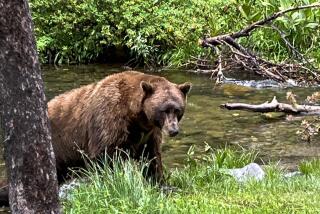For bears, corn spills are the feast of a lifetime : Train wrecks leave tons of grain, delighting grizzlies. But, as with any big meal, the cleanup takes forever.
- Share via
HUNGRY HORSE, Mont. — Grizzly bears are among nature’s most determined opportunists, eating most anything and willing to fight most anybody in their way.
So imagine in the spring of last year when the grizzlies of northern Montana awoke from winter’s hibernation to behold an opportunity to end all opportunities--an opportunity bigger and tastier than any famished bear ever fantasized. Imagine them awakening and finding more than 10,000 tons of grain corn dumped on their doorstep.
“For grizzly bears it was like dying and going to heaven,” said Forest Service District Ranger Allen L. Christophersen.
Ever since, however, it’s been a hellish chore for man to clean up his spilled corn and hold off a hungry stampede of wild grizzlies, and a few black bears, too.
The story begins with a freakish series of train derailments during the winter of 1988-89 on the Burlington Northern line east of here along the border of Glacier National Park.
In the first derailment, a westbound train coming down Marias Pass broke a wheel and sent 20 grain cars tumbling across the landscape. A month later, 32 cars derailed when a track broke at the same spot. And then just days later, in a winter storm with howling winds and 30-below temperatures, a train lost its brakes and 52 cars full of corn came flying off the tracks.
With each rail car carrying about 100 tons, the spills totaled more than 20 million pounds.
The bears awoke in spring and began to assist in the cleanup.
Rangers tell of 11 bears at any one time gorging on the mounds of corn. So blissfully content was one grizzly that it lay down on its side and simply scooped corn into its face until it could eat no more.
Bears dined in the morning, napped and returned in the evening to plunder again. The booty was so vast that little bears ate peaceably right along with the big ones, and even some black bears--which normally flee at the sight of the bully grizzlies--came to join in the feast.
As the corn ripened in the sun, some people worried about fermentation. Would the bears become not only fat and lazy, but drunk, too?
Turns out, however, a bigger problem was not the bears so much as the bear watchers attracted to the scene.
U.S. Highway 2 from Hungry Horse to Browning runs only a few hundred yards from the spill, and no sooner did the snow melt than carloads of summer tourists arrived and joined the wrecked rail cars, the corn and the bears for a regular inter-species wilderness hoedown.
It seems most everyone knows bears are unpredictable and dangerous. Well, not everyone. And coincidentally, those people who never got the word about bears all set out to travel U.S. 2. They pulled to the edge of the narrow mountain roads, yanked out cameras, lawn chairs, children, picnics. Oh what fun, that bear is only 50 feet away! Yeah, but see here--that one is even bigger, and closer, too!
Christophersen blanched. The bears were too near to the tracks and were in danger of being killed by trains. People were too near to the corn and in danger of being killed by the bears.
Signs were posted to mark the whole area off limits: no stopping, no parking, no trespassing. A nearby campground was closed. Law enforcement officials cruised the remote scene to shoo away disbelievers and dispense tickets to a few rubberneckers.
“One guy said: ‘Hey, I’m a cop from Cincinnati,’ ” Christophersen recalled. “He figured that qualified him to handle a bear. I tell you, we heard every excuse there is.”
Burlington Northern began scooping out the corn, a job that is still going on today. They had some experience at the task. In 1985, there was a corn spill in the very same treacherous pass. And in 1983, tons of barley were spilled in the area. The latest spill has cost the railroad $3.9 million so far.
“I figured we were going to have to deal with this for at least three summers,” Christophersen said the other day as he surveyed the scene.
This is summer No. 2.
A sizzling 9,600-volt electrified fence has been put up around several acres down a steep embankment where the corn has sifted into the rocks and removal has been hardest. A few bears have broken in, but the fence seems to be holding. Corn plants that popped up from the seed have been pulled. The situation is stable, but not solved.
The sickly, sweet smell of rotting corn fills the air, and fresh mounds of scat and diggings show that the grizzlies of northern Montana still find corn where the cleanup crews cannot.
Three bears have been killed by passing trains--two last summer and one so far this summer. The hazard will remain for years.
Wildlife biologists figure that even when the last kernel of corn is hauled off or rotted away, bears will remember and visit the scene each spring just to double check. This will likely go on for as long as they live, which for grizzlies is about 25 years.
That means a cub that visited the site in 1990 will be dropping by in 2001--perhaps telling its disbelieving offspring the legend about that year when the great steel cars gave up mountains of corn, about that spring when the corn was deeper than the snow.
More to Read
Sign up for Essential California
The most important California stories and recommendations in your inbox every morning.
You may occasionally receive promotional content from the Los Angeles Times.













